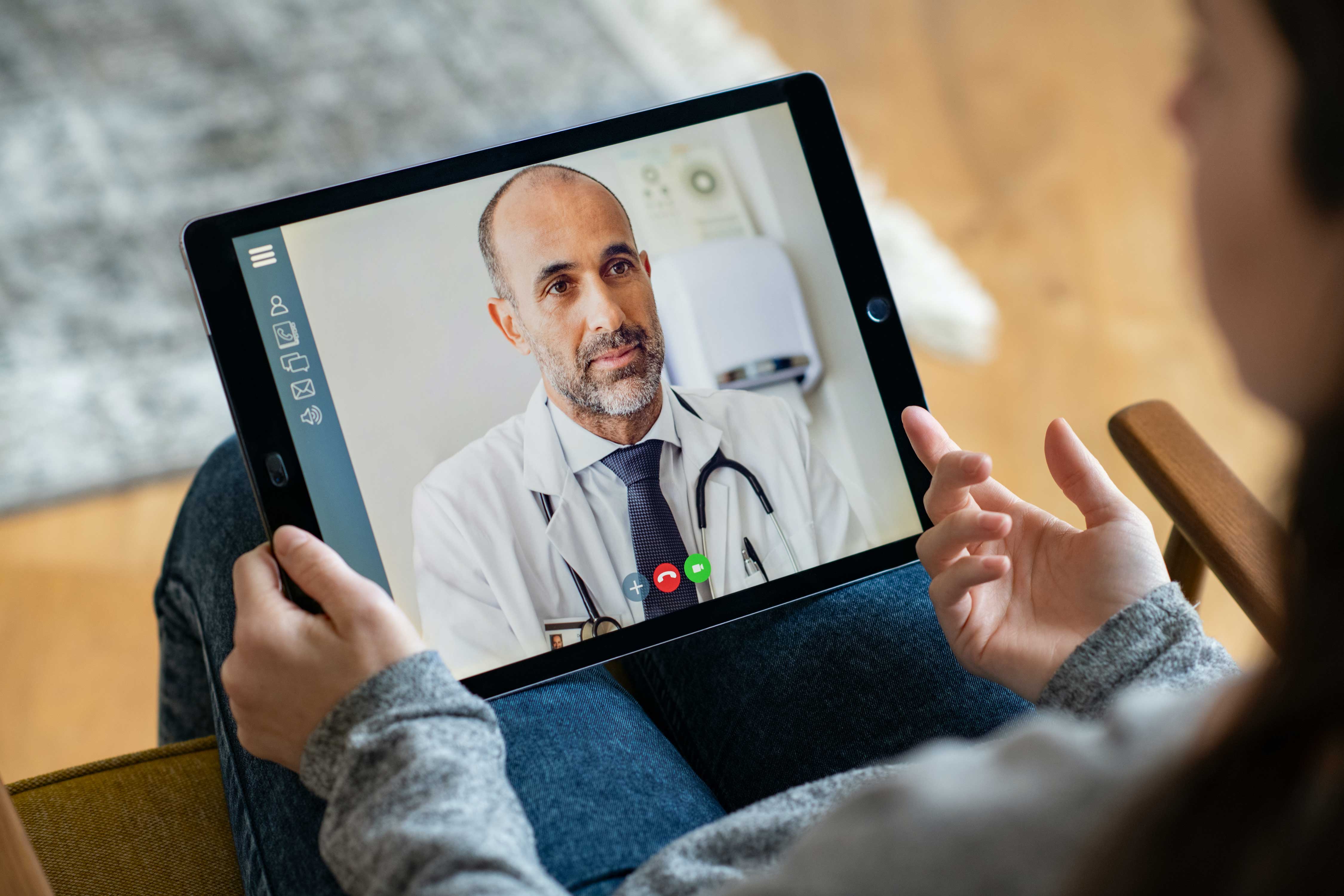What is healthcare consumerism?
Healthcare consumerism, a growing trend in the healthcare industry, is when individual patients, also known as healthcare consumers, have control over their own health affairs via digital channels.
Healthcare consumerism means patients have easy access to a wide range of healthcare services—and to a broad swath of the healthcare landscape. Points of access include websites, mobile apps, and cloud-based channels. The healthcare sector, in terms of digital service delivery, is catching up to other industries, but still lags far behind.
Consumers increasingly demand telehealth tools which allow them to:
- Find healthcare providers who satisfy the patient's specific preferences.
- Self-schedule their own appointments in health systems.
- Compare hospitals and healthcare providers.
- Access patient portals, where they can manage their medical services, make appointments, and learn about health policy.
- Digitally order prescription drugs and request medication delivery.
- Understand pricing and price transparency: out of pocket costs, financial incentives, payment plans, health savings account information, health reimbursement arrangements, flexible spending accounts data, high deductible health plans info.
- Learn about healthcare provider quality and read online reviews with accurate information.
- Access to Covid-19 information.
Seamless consumer access to these tools empowers patients to make the best healthcare decisions for their own health. This access also allows patients to more easily navigate the complex American healthcare system.
Because of the rise of healthcare consumerism, patients are more conscientious of healthcare costs and their associated benefits. Consumers can make value-based judgments while comparison shopping; they can choose the health insurance plan most suitable for themselves and their families. In the case of employers, the employee can help pay for and manage his or her benefits directly.
Healthcare consumerism has numerous benefits, from better care quality to lower overall costs. Organizations that take advantage of healthcare consumerism trends can improve the patient experience, strengthen patient engagement, and enhance remote care.
The rapid development and enormous popularity of healthcare consumerism is an opportunity too ripe for health organizations to pass up.
What is the driving force behind healthcare consumerism?
Healthcare consumerism is not a new concept in the healthcare industry—but it has surged in popularity in recent years. Below is a brief history of healthcare consumerism:
- Rise of value-based care, High Deductible Healthcare Plans (HDHP), and direct-to-consumer sales of drugs: In the early '80s, healthcare consumers started to participate in medical decision making with healthcare systems. In 1997, the FDA imposed stringent restrictions regarding radio advertisements for pharmaceutical products. Pharmaceutical companies began distributing more direct advertisements in their stores for medical treatments and drugs, which led to a growing consumer interest in health care.
- Healthcare consumerism and digital technology: Changing consumer demands have come with the internet and smartphones. Many patients—accustomed to having instant access to almost any conceivable service on their mobile devices—now demand the same for their health affairs.
Why is healthcare consumerism important for healthcare providers?
Embracing healthcare consumerism is critical for providers who want to remain competitive in today's digital world. Healthcare consumerism allows providers to improve the health experience for consumers, who now demand full ownership of their medical services. Healthcare providers who embrace, rather than avoid, healthcare consumerism trends see numerous benefits:
- Patient acquisition and patient loyalty.
- Lower cost of overhead and other expenses.
- A better relationship with healthcare payers.
- Superior health plan opportunities.
- A brand that stands out from other providers.
- Greater physician satisfaction.
- Exceptional service quality.
- Positive patient outcomes.
How can healthcare organizations utilize healthcare consumerism trends to improve healthcare services and lower healthcare costs?
There are several ways that health systems can take advantage of healthcare consumerism trends to enhance their operations:
Online search (how to get found)
Healthcare search is local. Local search consists of two types:
- Objective search: An example: Patients want to find the specialty that is the closest. This requires both an accurate address and one that is encoded in search engines. Other common objective search items include:
-
- Types of insurance accepted.
- Types of procedures performed.
- Days and hours open.
- Experience, age, and sex of providers.
- Types of insurance accepted.
Consumers must be able to easily find your organization by entering certain keywords on a search engine: Google, Bing, Apple, Alexa, Facebook, WebMD, Vitals, Yelp, and more. Creating and maintaining accurate and engaging profiles on these platforms is called healthcare syndication.
Healthcare syndication is a critical component of getting found in online search results. Tools like Care Desk—with its database of providers, locations, and procedures—can conduct healthcare syndication for any health practice.
- Subjective search: Patients want advice—and they want to know who to trust—so that they can make the best healthcare choices for themselves and their families. You can build repute with patients by offering useful health information on your website—typically in long-form content such as blog posts. Newsletters and nurturing emails are also an excellent way for health organizations to establish themselves as thought leaders in their speciality.
Selection (how to get chosen)
Positive reviews of health practices often strengthen patient trust. 79% of consumers read reviews before making healthcare decisions.
That said, even if a provider has established trust, patients still may not schedule if the provider doesn't have an easy schedule link or offer online self-scheduling. Consumers are increasingly wary of calling health practices and waiting on hold. Providers must offer digital service suited for modern consumer demands.
Conversion (how to get the appointment)
Health organizations can optimize conversions by making it easy for patients to schedule their own appointments. Self-scheduling has countless benefits for health systems:
- A satisfying and seamless consumer experience: With self-scheduling, patients aren't burdened with the need to call their provider and wait on hold. They can schedule whatever health services they need on their devices.
- Lower costs: Self-scheduling takes an enormous burden off of healthcare phone staff, which means providers hire less staff and the staff they do hire need less training. This substantially reduces overhead expenses.
- Physician satisfaction: A sophisticated self-scheduling platform allows doctors to utilize 100% of their schedule. Appointments are distributed evenly, are always accurate, and if a patient cancels, automatic waitlisting fills empty slots.
Scheduling optimization tools (how to fill your calendar)
Patients aren't the only ones who gain from healthcare consumerism. Physicians and support staff also see benefits—particularly in regards to scheduling. AI-powered Intelligent Scheduling automates all appointment types, from sequential to surgery, which means doctors get an accurate and equitable schedule, and support staff get fewer phone calls.
Top features of Intelligent Scheduling include:
- Automatic waitlisting and rescheduling.
- Round-robin scheduling.
- AI-automated complex scheduling.
To learn more about Intelligent Scheduling, read our Intelligent Scheduling Whitepaper.
Post-visit scheduling and healthcare marketing (how to build on the relationship)
A holistic healthcare consumerism strategy includes patient outreach and patient engagement campaigns. These campaigns contain preventive medicine information, SMS scheduling links, Covid-19 news, health education emails, and more. Combined, these marketing efforts offer a superior patient experience—which in turn drives organizational growth and expands brand visibility.
To read more about healthcare marketing campaigns, click here.
What can an employer do to promote consumerism in healthcare?
Because of the rise of healthcare consumerism, employees now demand more control over the health insurance plans offered by their employers. Which means businesses must offer flexible health insurance policies that account for individual preferences. Employers should make a wide range of health plans available—with full price transparency.
Group health plans often don't account for individual patient profiles. Each employee has unique health needs, and these needs sometimes require specific health plans. Workers often face a dilemma: they either don't need all the benefits offered by their employer's health insurance, or they need more benefits than what are offered by their employer's health insurance. In the age of healthcare consumerism, employers must make individualized care a top priority.
The future of healthcare consumerism
Almost all commerce now takes place online. Consumers order household necessities and groceries, from toilet paper to eggs, on Amazon and Instacart. Consumers book transportation and lodging, from plane flights to hotels, on Uber and Expedia. And consumers engage with health services, from scheduling to communication, on digital channels.
This digital health revolution was inevitable. It was only a matter of time before patients demanded the same control, access, and personalization from their healthcare as they got from everything else. Patients want to schedule their own appointments; patients want to compare doctors; patients want to communicate securely with their caregiver.
Modern consumers demand value-based care. They demand price transparency. They demand holistic telehealth. Healthcare organizations that offer this modern consumer experience will thrive—healthcare organizations that don’t will die.
To read more about cutting-edge patient access, check out our blog: "Uniting Patient 360 & Provider 360 Is The Future Of Patient Access."









